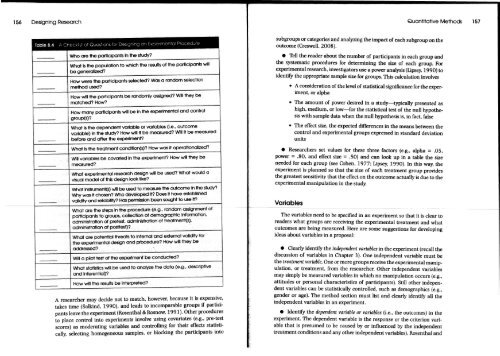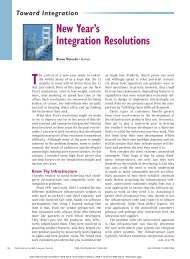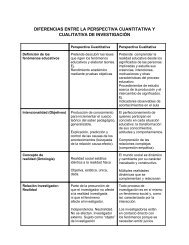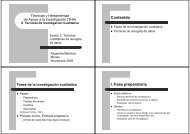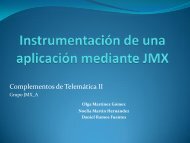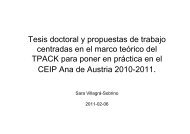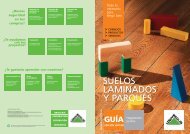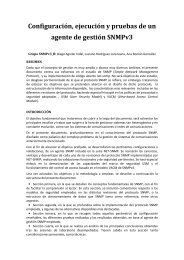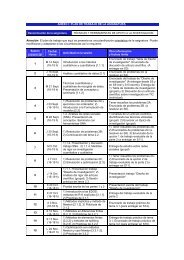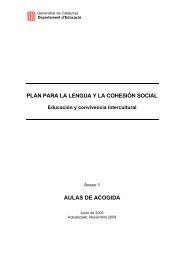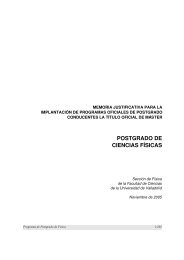Research Questions and Hypotheses
Research Questions and Hypotheses
Research Questions and Hypotheses
Create successful ePaper yourself
Turn your PDF publications into a flip-book with our unique Google optimized e-Paper software.
156 Designing <strong>Research</strong><br />
Quantitative Methods 157<br />
Table 8.4 A Ct)ecklist of <strong>Questions</strong> for Designing an Experimental Procedure<br />
Who are the participants In the study?<br />
What is the population to which the results of the participants will<br />
be generalized?<br />
How were the participants selected? Was a r<strong>and</strong>om selection<br />
method usad?<br />
How will the participants be r<strong>and</strong>omly assigned? Will they be<br />
matched? How?<br />
How many participants will be in the experimental <strong>and</strong> control<br />
group(s)?<br />
What is the dependent variable or variables (Le., outcome<br />
variable) In the study? How will tt be measured? Will it be measured<br />
before <strong>and</strong> after the experirnent?<br />
What is the treatment condition(s)? How was ti operationalized?<br />
Will variables be covaried In the experlment? How will they be<br />
measured?<br />
What experimental research design will be used? What would a<br />
visual model of this design look Ilke?<br />
What instrurnent(s) will be used to measure the outcome in the study?<br />
Why was it chosen? Who developed it? Does it have established<br />
validity <strong>and</strong> reliability? Has permission been sought to use it?<br />
What are the steps in the procedure (e.g., r<strong>and</strong>om ássignment<br />
participants to groups, collection of demographic information,<br />
administration of pretest, administration of treatment(s),<br />
administration of posttest)?<br />
What are potential threats to interna' <strong>and</strong> externa' validity for<br />
the experimental design <strong>and</strong> pfbcedure? How will they be<br />
addressed?<br />
Will a pilot test of the experiment be conducted?<br />
What statistics will be used to analyze the data (e.g., descriptive<br />
<strong>and</strong> inferential)?<br />
How will the resutts be interpreted?<br />
A researcher may decide not to match, however, because it is expensive,<br />
takes time (Salkind, 1990), <strong>and</strong> leads to incomparable groups if participants<br />
leave the experiment (Rosenthal & Rosnow, 1991). Other procedures<br />
to place control into experiments involve using covariates (e.g., pre-test<br />
scores) as moderating variables <strong>and</strong> controlling for their effects statistically,<br />
selecting homogeneous samples, or blocking the participants into<br />
subgroups or categories <strong>and</strong> analyzing the impact of each subgroup on the<br />
outcome (Creswell, 2008).<br />
Tell the reader about the number of participants in each group <strong>and</strong><br />
the systematic procedures for determining the size of each group. For<br />
experimental research, investigators use a power analysis (Lipsey, 1990) to<br />
identify the appropriate sample size for groups. This calculation involves<br />
A consideration of the level of statistical significance for the experiment,<br />
or alpha<br />
The amount of power desired in a study—typically presented as<br />
high, medium, or low—for the statistical test of the null hypothesis<br />
with sample data when the null hypothesis is, in fact, false<br />
The effect size, the expected differences in the means between the<br />
control <strong>and</strong> experimental groups expressed in st<strong>and</strong>ard deviation<br />
units<br />
<strong>Research</strong>ers set values for these three factors (e.g., alpha = .05,<br />
power = .80, <strong>and</strong> effect size = .50) <strong>and</strong> can look up in a table the size<br />
needed for each group (see Cohen, 1977; Lipsey, 1990). In this way, the<br />
experiment is planned so that the size of each treatment group provides<br />
the greatest sensitivity that the effect on the outcome actually is due to the<br />
experimental manipulation in the study.<br />
Variables<br />
The variables need to be specified in an experiment so that it is clear to<br />
readers what groups are receiving the experimental treatment <strong>and</strong> what<br />
outcomes are being measured. Here are some suggestions for developing<br />
ideas about variables in a proposal:<br />
Clearly identify the independent variables in the experiment (recall the<br />
discussion of variables in Chapter 3). One independent variable must be<br />
the treatment variable. One or more groups receive the experimental manipulation,<br />
or treatment, from the researcher. Other independent variables<br />
may simply be measured variables in which no manipulation occurs (e.g.,<br />
attitudes or personal characteristics of participants). Still other independent<br />
variables can be statistically controlled, such as demographics (e.g.,<br />
gender or age). The method section must list <strong>and</strong> Clearly identify all the<br />
independent variables in an experiment.<br />
Identify the dependent variable or variables (i.e., the outcomes) in the<br />
experiment. The dependent variable is the response or the criterion variable<br />
that is presumed to be caused by or influenced by the independent<br />
treatment conditions <strong>and</strong> any other independent variables). Rosenthal <strong>and</strong>


